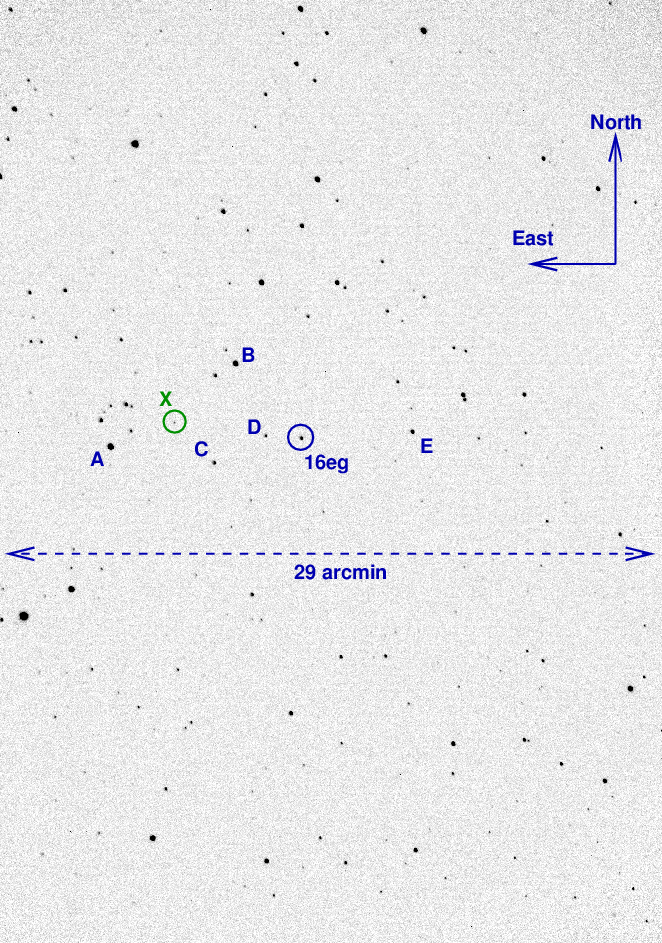
On the night of Apr 16/17, 2016, I acquired a set of observations of the cataclysmic variable star ASASSN-16eg. The variable star showed an average magnitude of about 13.4 (about the same as two nights ago) but the amplitude of its variations increased greatly. Yippee!
The main setup was:
I switched to using no filter in order to get more signal.
This cataclysmic variable star was noticed by the ASASSN search recently.
I have other observations of the object on
The object is located at
RA = 17:26:10.36 Dec = 42:20:02.7
A chart of the field is shown below. The size of the chart is about 44 arcmin tall (North-South) and 29 arcmin wide (East-West). This rather unusual portrait-mode orientation is forced on us if we use the off-axis guider on the new ATIK 11000 camera.
The star labelled "X" is an eclipsing variable known as CSS_J172638.9+422054

Entries for some of the marked comparison stars from the UCAC4 follow:
star UCAC4 B V ---------------------------------------------------- A 662-062549 11.569 10.476 B 662-062523 11.434 10.970 C 662-062528 13.831 13.170 D 662-062515 14.533 13.817 ----------------------------------------------------
I used 30-second exposures with no filter. The signal-to-noise ratio was indeed better than it had been with a V filter and 40-second exposures.
Conditions were good. The quarter moon set early in the run, and the skies were dark. Measurements of the sky background value show a smooth decrease as the field rose, until dawn came. No clouds!
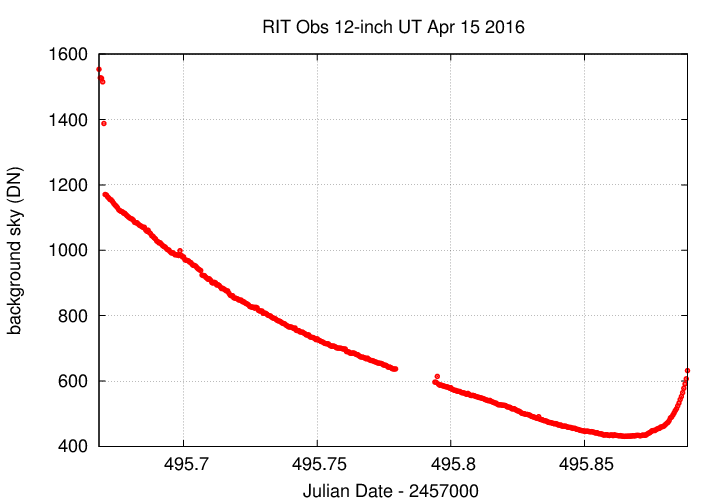
The lack of guider really hurt, as stars drifted across the chip. I tried to make manual corrections every 10 minutes or so to keep stars in roughly the same position on the detector, but some of the scatter in the final measurements must be due to variations as sources moved from one region to another.
As before, I removed any measurements which were made more than 600 pixels (791 arcsec = 13.2 arcmin) from the center of the field.
Using aperture photometry with a radius of 5 pixels (radius of 6.7 arcsec), I measured the instrumental magnitudes of a number of reference stars and the target. Following the procedures outlined by Kent Honeycutt's article on inhomogeneous ensemble photometry, I used all stars available in each image to define a reference frame, and measured each star against this frame.
Sigma-vs-mag plots show that the floor was about 0.005 mag. ASASSN-16eg is the outlier at diff mag = 3.9.
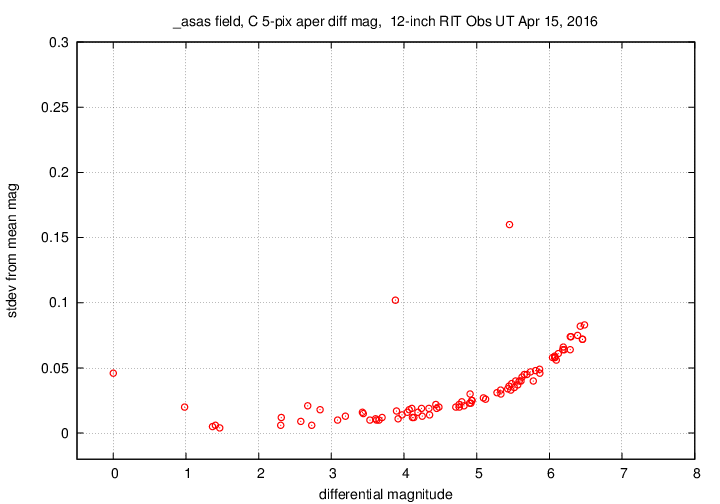
Image adjustment factor shows no evidence for clouds, just lots of outliers due to trailed images.
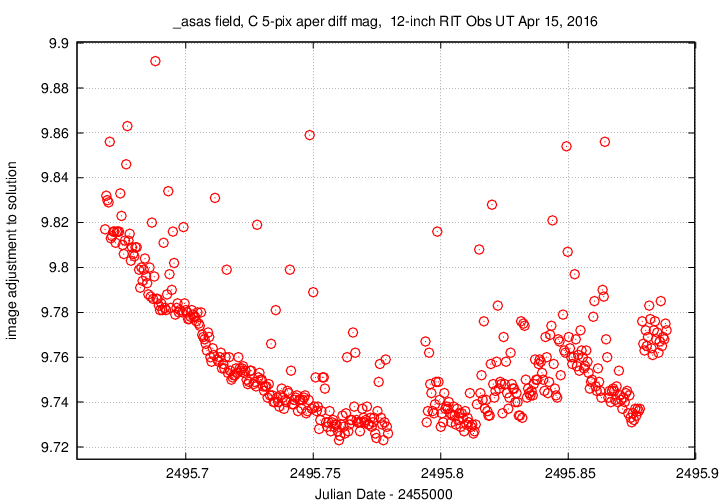
Here are light curves of the variable and the field stars:
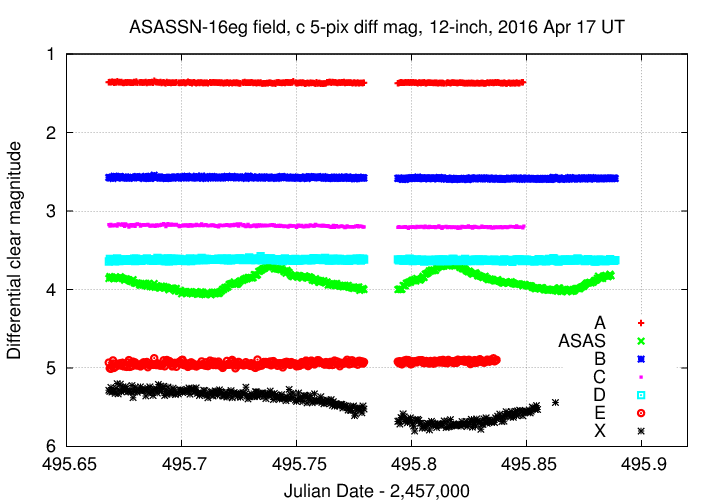
Note the star shown in black symbols, labelled "X" in the graph above and in the chart shown earlier. That star is actually CSS_J172638.9+422054 , also known as
UCAC4 662-062534 RA = 17:26:38.9 Dec = +42:20:54.2 V = 15.0
The light curve on this night shows a dip (eclipse, I suspect) of depth 0.6 mag or so, lasting for 4-5 hours. I don't recall seeing any similar dips on previous nights, so if this is an eclipsing binary, it likely has a period longer than a few days.
Edit: Thanks to Jim Jones for pointing out that this variable is CSS J172638.9+422054. According to VSX, it has a 0.62-day period and an amplitude of 0.40 mag
A closeup shows the variations in ASASSN-16eg more clearly.
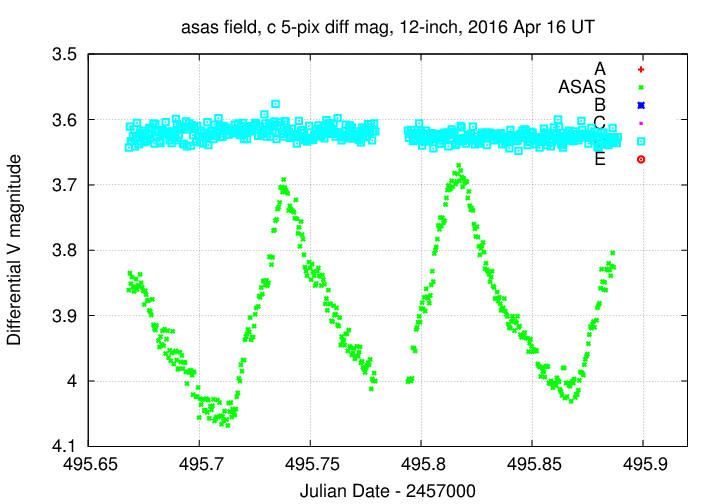
I used the UCAC value for the V-band magnitude of star "C" = UCAC4 662-062528 to shift the ensemble magnitudes to the standard V-band scale -- but remember that these are UNFILTERED measurements. You can download my measurements below. A copy of the header of the file is shown to explain the format.
# Measurements of ASAS_SN16eg made at RIT Obs, Apr 17, 2016 UT, # in good conditions. # by Michael Richmond, using 12-inch Meade and ATIK 11000 CCD. # Exposures 30 seconds long, no filter. # Tabulated times are midexposure (FITS header time - half exposure length) # and accurate only to +/- 1 second (??). # 'mag' is a differential magnitude based on ensemble photometry # using a circular aperture of radius 6.6 arcseconds. # which has been shifted so UCAC4 662-062528 has mag=13.170 # which is its V-band mag according to UCAC4. # # UT_day JD HJD mag uncert Apr17.16833 2457495.66833 2457495.66996 13.422 0.015 Apr17.16880 2457495.66880 2457495.67043 13.396 0.014 Apr17.16926 2457495.66926 2457495.67089 13.412 0.014
Last modified 4/28/2016 by MWR.